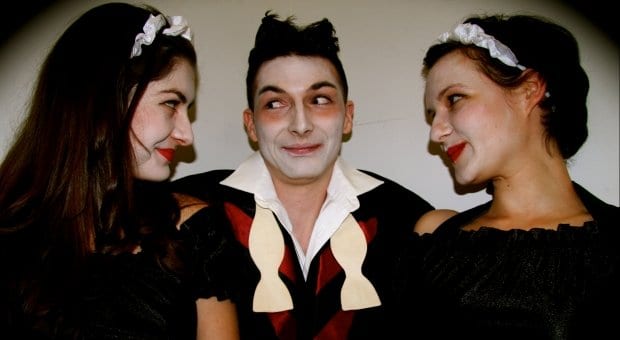As a chilling and enjoyable lead-up to Halloween, Art and Lies Productions presents Eugne Ionesco’s Killing Game, a darkly funny play about a small community dealing with death. The play begins with “a monk figure dressed in black who shows up in the town square and then a plague begins to ravage the citizens,” director Rosanna Saracino says. “We see uprising and destruction of various governments.”
The production is inspired by theatre of the absurd, so it’s “very dark and very damning,” Saracino says. There is a lot of physical humour and many highly choreographed scenes that take full advantage of the 18-member cast. Each scene is not necessarily related to the next, and there is very little continuity of character, but, as Saracino puts it, in each scene “someone or everyone dies.” The location of the town is never specified, and the plague is likewise ambiguous, though many in the cast have noticed strong similarities to the HIV/AIDS epidemic.
It’s as serious as it sounds and yet still highly amusing. There’s lots of scathing social commentary, which manifests through some serious flaw in each of the characters, brought to the forefront by the threat of death. “What we do, or what the style warrants, is we heighten that aspect of character until it becomes preposterous or absurd, so the play’s hilarious,” Saracino says.
Adam Barrett and the rest of the cast have had a lot of fun working on their characters. Because each character is larger-than-life, they haven’t had to hold themselves back. In Saracino’s words, “For each role, there’s grandeur and scale and almost boundless permission to really explore the full thrust of a life in a hysterical, primal moment.”
Barrett plays eight roles. “Each of them is a different cartoon character. One guy is big and posturing, sort of Marquis de Sade and peacocky, and there’s another character that is wimpy, like a tiny dog,” he says. “That’s not to say there isn’t subtext in the work, but a lot gets to come to the front.”
The town is home to characters of various predilections. At least one of the characters Barrett plays is probably gay, though there’s very little necking going on in town, what with the plague and all.
The ending is no secret: everybody dies. There’s no “the butler did it!” moment. “The surprise lies in how people actually deal with the plague,” Saracino says.
Killing Game runs Mon, Oct 14–Fri, Oct 18 at Annex Theatre, 736 Bathurst St. artandliesproductions.com


 Why you can trust Xtra
Why you can trust Xtra


